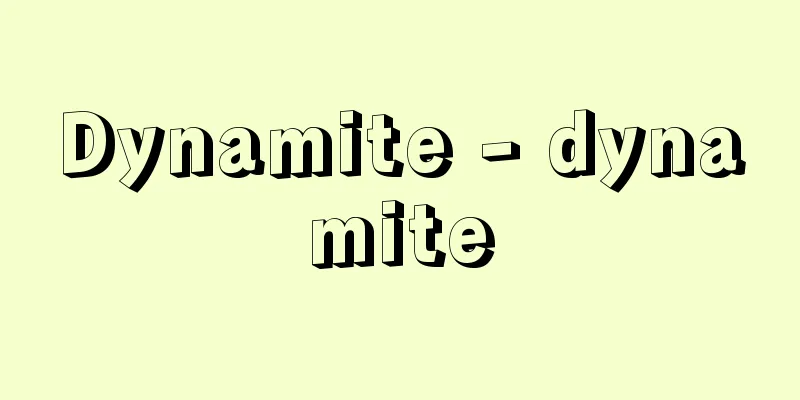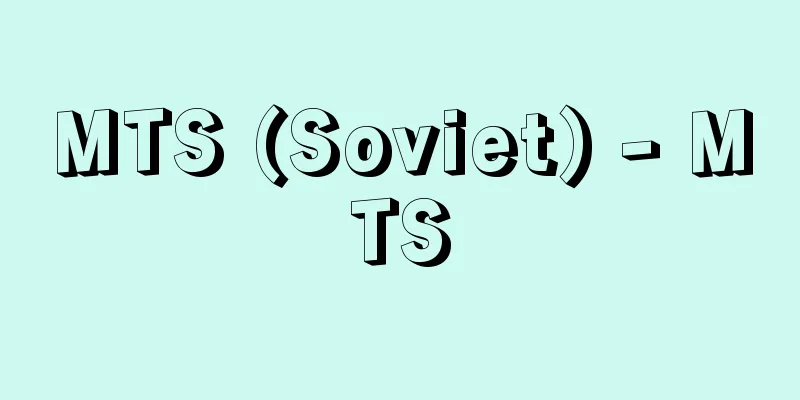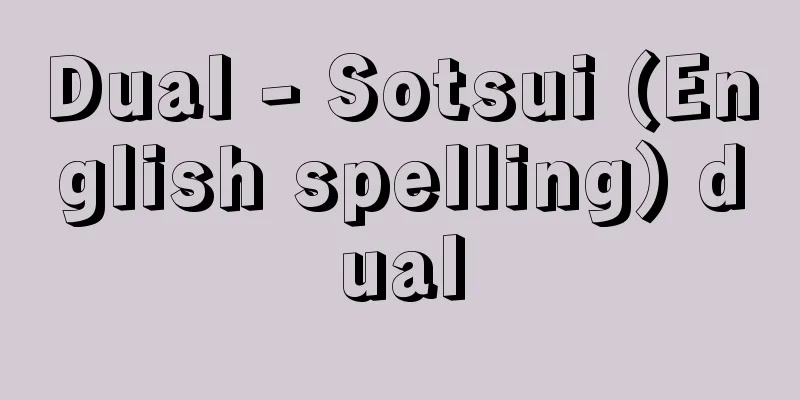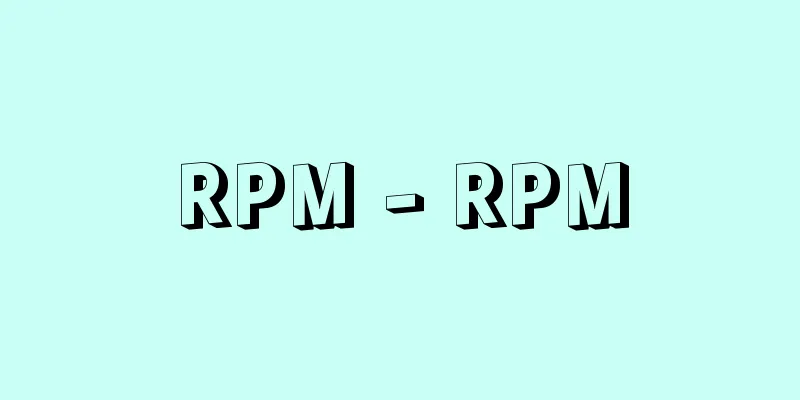Dynamite - dynamite

|
A general term for explosives containing nitroglycerin, invented by Sweden's Nobel. There are mixed dynamites and nitrogel-based dynamites, the former being used in America and the latter in Europe and Japan. In Japan, dynamite is defined as anything that contains more than 6% nitrogel, made by mixing nitroglycerin or a mixture of nitroglycerin and nitroglycerin with nitrocellulose. The word dynamite is derived from the Greek word dynamis, meaning "force" or "motion," due to its powerful explosive power. [Tadao Yoshida and Shingo Date] Invention and development historyIn 1846, nitroglycerin was synthesized by the Italian Sobrero, and it was found to have a much stronger explosive power than the black powder that had been used until then. Nobel invented the detonator (1864) as a way to ensure that nitroglycerin would detonate, as it did not explode easily when ignited. Since nitroglycerin explodes with just a slight blow and is very dangerous, he invented the safer diatomaceous earth dynamite in 1866 by absorbing it into diatomaceous earth. Although diatomaceous earth dynamite was safe, the problem remained that its explosive power was weak, at about 70% of that of nitroglycerin. In 1875, Nobel discovered that mixing nitroglycerin with nitrocellulose, which had a nitrogen content of about 12%, produced a rubbery or gelatinous mass that had a stronger explosive power than diatomaceous earth dynamite, and named it gelatin dynamite (nitrogel). In Europe and Japan, dynamites based on this nitrogel were developed, and dynamites made by adding admixtures such as ammonium nitrate, sodium nitrate, wood powder, starch, and nitro compounds to nitrogel became mainstream. In the United States, mixed dynamite is mainly used, in which nitroglycerin is directly mixed with an admixture without using nitrocellulose. Straight dynamite uses sodium nitrate, wood powder, starch, and other admixtures, while ammonia dynamite also uses ammonium nitrate. As mentioned above, diatomaceous earth dynamite is made by absorbing nitroglycerin into diatomaceous earth. However, these explosives are highly sensitive, and there is a risk that the nitroglycerin will leak out if the storage temperature rises, so they are not manufactured in Japan. The use of nitrocellulose as an admixture has the advantages of reducing the cost of dynamite, increasing its plasticity to make it easier to handle, adjusting the explosive power, and suppressing deterioration. Dynamite with a nitrogel content of 6-18% is in powder form and is called powdered dynamite, while dynamite with a nitrogel content of 18% or more is in the form of glue and is called gelatinous dynamite. In Japan, dynamite is classified by the names of plants, such as pine, cherry, paulownia, enoki, and katsura. Colloid dynamite is made by mixing nitrogel with additives, forming it into a rod shape, and wrapping it in paper. Powder dynamite is made by mixing nitrogel with additives, filling a pre-made paper tube, and sealing the top. [Tadao Yoshida and Shingo Date] Advantages and DisadvantagesDynamite has the following features: high explosive power, clean after-gas produced by the explosion, and good sympathetic detonation, which allows adjacent explosive packets to detonate even if there is a gap between them. For these reasons, it maintained its position as the leading industrial explosive until the latter half of the 20th century. However, there are some problems. Because it contains nitrate esters such as nitroglycerin and nitrocellulose, it has stability problems, and stability tests are required by law. In addition, there is a deterioration phenomenon in which the detonation velocity decreases during storage, and a death pressure phenomenon in which explosion does not occur when a certain amount of pressure is applied. Furthermore, nitroglycerin can freeze and become dangerous, and although this concern has now been eliminated because it contains nitroglycerin, nitroglycerin and nitroglycerin are toxic, and there is also a risk of nitroglycerin leaking out. Due to these problems, dynamite was replaced by ammonium nitrate oil explosives and water-containing explosives in the early 1980s, and the production of dynamite now accounts for only a few percent of the total industrial explosives. [Tadao Yoshida and Shingo Date] "Industrial Explosives" edited by Michio Yamakawa (1982, Japan Industrial Explosives Society)" ▽ "Introduction to Explosives Science" by Shoji Nakahara (1983, Sangyo Tosho) ▽ "Handbook of Energetic Materials" 2nd Edition (edited by the Explosives Society and supervised by Shozo Tamura, 2010, Kyoritsu Shuppan)" ▽ "Paul W. Cooper Explosives Engineering (1996, Wiley-VCH, Berlin)" [References] | | |©Shogakukan "> Japanese dynamite composition ©Shogakukan "> Example of mixed dynamite composition Source: Shogakukan Encyclopedia Nipponica About Encyclopedia Nipponica Information | Legend |
|
スウェーデンのノーベルが発明した、ニトログリセリンを含有する爆薬の総称。混合ダイナマイトとニトロゲル系ダイナマイトがあり、アメリカでは前者が、ヨーロッパや日本では後者が使われている。日本ではニトログリセリンまたはニトログリセリンとニトログリコールの混合物にニトロセルロースを配合してできたニトロゲルが6%を超えるものをダイナマイトとよんでいる。ダイナマイトの語は、その強力な爆発威力により「力」「運動」を意味するギリシア語のデュナミスdynamisからつくられた。 [吉田忠雄・伊達新吾] 発明と発展史1846年イタリアのソブレロによってニトログリセリンが合成され、その爆発威力が、それまで用いられてきた黒色火薬に比べて格段に強いことがわかった。ノーベルは、火をつけただけでは簡単に爆発しないニトログリセリンを確実に起爆させる方法として雷管を発明(1864)した。ニトログリセリンはわずかな打撃で爆発し、非常に危険なので、これを珪藻土(けいそうど)に吸収させて、より安全な珪藻土ダイナマイトを1866年に発明した。 珪藻土ダイナマイトは安全ではあったが、爆発威力はニトログリセリンの70%程度で弱いという問題点が残っていた。1875年ノーベルは、ニトログリセリンと窒素量が12%台のニトロセルロースを混ぜるとゴム状またはゼラチン状の塊となり、これが珪藻土ダイナマイトより強力な爆発威力をもつことを知り、ゼラチンダイナマイト(ニトロゲル)と名づけた。ヨーロッパや日本ではこのニトロゲルを基剤としたダイナマイトが発展し、ニトロゲルに硝酸アンモニウム、硝酸ナトリウム、木粉、デンプン、ニトロ化合物などの混和剤を加えたダイナマイトが主流となった。 アメリカでは、ニトロセルロースを用いずニトログリセリンを直接混和剤と混ぜた混合ダイナマイトがおもに用いられている。ストレートダイナマイトは混和剤として硝酸ナトリウムや木粉、デンプンその他を用いたものであり、アンモニアダイナマイトはそのほかに硝酸アンモニウムを用いたものである。珪藻土ダイナマイトは、前述のようにニトログリセリンを珪藻土に吸収させたものである。しかし、これらの爆薬は感度が鋭感であり、また、貯蔵温度の上昇などによりニトログリセリンが抜け出す危険性があるため、日本では製造されていない。 混和剤としてニトロセルロースを用いることによってダイナマイトのコストを下げ、可塑性を増して取扱いを容易にし、爆発威力を調節し、劣化を抑えるなどの利点が得られた。ニトロゲル含量が6~18%のものは粉状で粉状ダイナマイトとよばれ、18%以上のものは膠(にかわ)状で膠質(こうしつ)ダイナマイトとよばれる。日本ではダイナマイトは松、桜、桐(きり)、榎(えのき)、桂など植物の名を冠して区別されている。 膠質ダイナマイトは、ニトロゲルを混和剤と練り混ぜて、棒状に成形し、紙で包装してつくられる。粉状ダイナマイトはニトロゲルを混和剤と混合し、あらかじめつくっておいた紙筒に填薬(てんやく)し、口締めしてつくられる。 [吉田忠雄・伊達新吾] 特長と欠点ダイナマイトの特長は、爆発威力が大きいこと、爆発でできるあとガス(後ガス)がきれいであること、隣の爆薬包をたとえ間隙(かんげき)があっても伝爆させる殉爆性がよいことなどである。このため20世紀後半ごろまで工業爆薬の王座を保ってきた。 しかし、いくつかの問題点もある。ニトログリセリンやニトロセルロースのような硝酸エステルを含有しているため安定性に問題があり、安定度試験が法規で義務づけられている。また、貯蔵中に爆速が小さくなる劣化現象や、ある程度以上の圧力をかけると爆発がおこらなくなる死圧現象がある。さらに、ニトログリセリンが凍結して危険な状態となることがあり、現在はニトログリコールが入っているためにこの心配はなくなったものの、ニトログリコールやニトログリセリンには毒性があり、また、ニトログリセリンがしみ出す危険性もある。このような問題のため、1980年代前半には硝安油剤爆薬や含水爆薬がダイナマイトにとってかわられ、ダイナマイトの生産量は産業用爆薬類全体の数パーセントにすぎなくなった。 [吉田忠雄・伊達新吾] 『山川道雄編『産業火薬』(1982・日本産業火薬会)』▽『中原正二著『火薬学概論』(1983・産業図書)』▽『火薬学会編、田村昌三監修『エネルギー物質ハンドブック』第2版(2010・共立出版)』▽『Paul W. CooperExplosives Engineering(1996, Wiley-VCH, Berlin)』 [参照項目] | | |©Shogakukan"> 日本のダイナマイトの配合組成 ©Shogakukan"> 混合ダイナマイトの組成例 出典 小学館 日本大百科全書(ニッポニカ)日本大百科全書(ニッポニカ)について 情報 | 凡例 |
Recommend
Mori [town] - Mori
A town in Kayabe-gun, Hokkaido. The town is served...
Kyusoutei
…It is in the architecture of the teahouse that w...
Kikujutsu
Ki means "bunmawashi" (a circular movem...
Gyoto - Gyoto
...It is said to contain less rotenone than Derri...
Dunhuang Mogao Caves - Dunhuang Mogao Caves
The Great Grottoes (Thousand Buddha Caves) are loc...
Ebugyo - Ebugyo
The title of a priest's role in Buddhist cerem...
Takanobu Kano
Year of death: 4th August 30th, Genna (1618.10.18)...
electric ray
…A general term for fish belonging to the order S...
Merwedekanaal - Merwedekanaal (English spelling)
A canal in the Netherlands. It starts at Gorinchem...
Strix uralensis (English spelling) Strixuralensis
…Of these, six species breed: the Great Horned Ow...
Agematsu Infrared Observatory
…In 1962, the International Polar Motion Observat...
Hikone [city] - Hikone
A city in central-eastern Shiga Prefecture, on the...
Cost of capital
The value sacrifice a company incurs for capital ...
Iwayagahara Tomb - Iwayagahara Tomb
...The coastal settlements of Toshi, Wagu, and Mo...
Index fossils
Fossils are useful for specifically learning abou...









